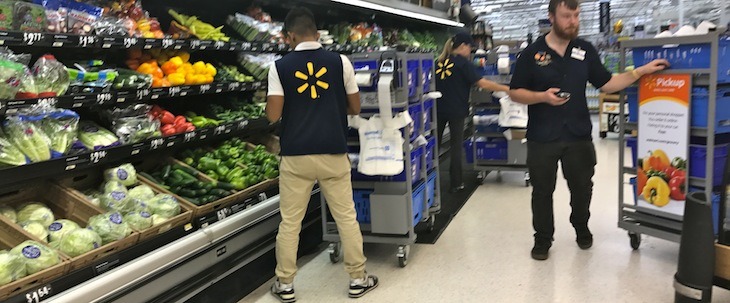Walmart claims to be more Millennial than Amazon, seeking higher online prices
by February 13, 2018 8:10 pm 1,841 views

Walmart U.S. employees work to fill orders placed online for store pickup.
Walmart officials recently told suppliers at its annual growth summit held near its home base in Bentonville the retail giant is winning favor with Millennials, claiming its online business and Jet.com have more Millennial customers than Amazon.
The retail giant claims 42% of Walmart.com and 65% of Jet.com customers are Millennials (ages 22-39) compared to 38% at Amazon. Generation X (ages 40-51) is a toss-up at 16% for Walmart.com and Amazon. Jet.com claims that 13% of its customers are Gen X. Boomers between the ages of 50 and 70 also shop Walmart.com and Amazon similarly. At Amazon, about 36% of its client base are Boomers, compared to 33% at Walmart.com and 38% at Walmart stores. Jet.com has far fewer Boomer customers at just 15%, according to a slide shown to suppliers at the recent forum.
Talk Business & Politics secured a copy of the transcript and slide deck from suppliers attending the event.
Walmart said its physical stores also do well with Millennials with the demographic comprising about 37% of total customers, slightly less than Amazon’s 38%. The retail giant said in just two years, Millennial spending power will surpass all other generations and if this demographic was a country the group would be the fifth largest in GDP.
The retailer also said Walmart.com and Jet.com customers have comparable incomes to Amazon customers. Walmart.com said 43% of its customers have incomes below $50,000 compared with 24% at Jet.com and 44% at Amazon. Jet.com was the winner with lower-middle-class incomes between 50,000 and 100,000 with 42% of customers at this income level. Walmart.com was lower with 31% of customers and Amazon still lower at 29% of customers, according to a slide shown to suppliers.
At the income level above $100,000 is where Jet.com said 34% of customers are located, better than the 27% of Amazon’s customer base and 26% of Walmart.com customers. Walmart U.S. e-commerce CEO Marc Lore has said Jet.com will focus on more urban, millennial shoppers with higher incomes that support premium brands. Walmart.com will offer a wide range of products and through marketplaces like the recent partnership with Lord & Taylor to also offer high-end items.
Keith Anderson, executive vice president of strategy and insights for Boston-based Profitero, said as Walmart and Amazon grow their household penetration it does make sense that income levels for each will approach the mean. Anderson said the data looks interesting, but one has to assume Walmart was including Bonobos, Moosejaw, Shoes.com and ModCloth to the Walmart.com customer bases.
U.S. e-commerce sales are expected to top $700 billion by 2022. Grocery, food and drinks are one of the fastest growing categories over the past three years with penetration growth rates of 10% in 2014, rising to 24% by 2017. A report by the Food Marketing Institute estimates 70% of U.S. consumers will buy groceries online by 2025. Walmart continues to roll out its online grocery pickup option to more stores and at the same time is asking suppliers for more items that fit e-commerce economics.
HIGHER ONLINE PRICES
Lore recently held meetings with Unilever, P&G and Kimberly Clark and other key suppliers to tell the vendors of the retail giant’s new focus on merchandise priced at a minimum of $5, preferably approaching $10 for online items.
This move toward soliciting higher priced goods is a fundamental shift in the direction of Walmart, a company that historically pressured suppliers to get lower costs that can be passed on to customers. The retailer just recently began charging more for items sold online than comparable products sold in stores. Anderson said it is curious for Walmart to show suppliers the comparison of itself with Amazon in terms of shopper base and income levels, but perhaps that was to set up the request for higher priced merchandise.
A recent study conducted by Profitero found Amazon to have the lowest overall prices online on 52,450 products also sold at Walmart, Jet.com and Target. Two separate three-month studies were done by Profitero in mid and late 2017 which found price gaps in grocery and consumables were narrowing between Amazon and Walmart.com, but Amazon was the low price retailer overall.
Walmart has experimented with “pickup in store” savings on some items, but Amazon saw that move and has lowered its prices to match the discount. Analysts wonder if the new higher online price strategy will work for Walmart long-term.
Dr. David Rogers of DSR Counseling group warned there could be issues for Walmart charging higher prices online than in its stores. He said retailers are starting to realize selling items online for a loss makes little sense. He said Amazon does it to some extent because it can reap revenue in its other businesses like web services.
Anderson said even Amazon is reviewing item pricing and is keeping track of products where they “can’t realize a profit” (CRaP). Those items are eventually dropped if they can’t become profitable.
Amazon is not without its own challenges as the Seattle-based tech retailer announced Monday it was trimming its corporate workforce in areas that are underperforming. The Seattle Times reports several hundred jobs are being cut over the next couple weeks from the retailer’s consumer retail division. Most the jobs are based in Seattle among the workforce of some 40,000.
Amazon sent the following statement regarding the corporate downsizing: “As part of our annual planning process, we are making headcount adjustments across the company — small reductions in a couple of places and aggressive hiring in many others. For affected employees, we work to find roles in the areas where we are hiring.”
